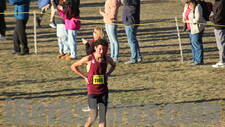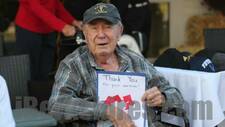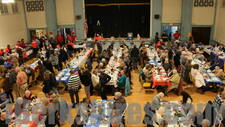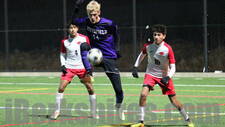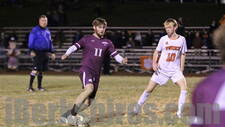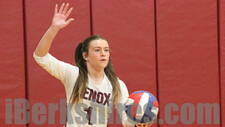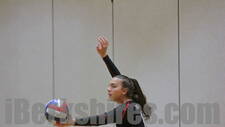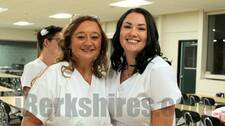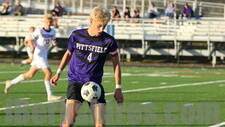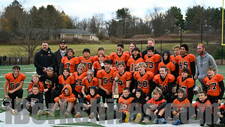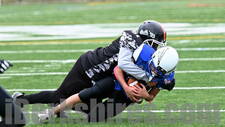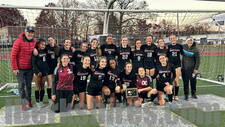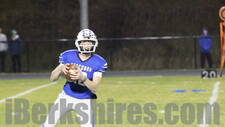Bytes from the Bean by Joe Manning 11-1-9912:00AM / Monday, November 01, 1999
When I was growing up, I wanted to be somebody. Later, I found out that I should have been more specific."
-Lily Tomlin
"Teach your children well."
-Graham Nash of Crosby, Stills, and Nash
"The more you learn, the more you want to learn."
-I have no idea who said this.
On Thursday, October 21st, I was privileged to attend the Community Service Learning Conference held at the MCLA Church Street Center (formerly the Synagogue). I presented a workshop to teachers and students on how to become involved in oral history projects and the study of historic tenements and multi-family houses in their communities. I have been working on oral history projects with seventh graders in Deborah Bullett's classes at Conte for several years. This was my first experience with the Community Service Learning program.
There were numerous workshops all morning and at least two hundred energetic teachers and students there. After the workshops, we all had a great lunch together, heard two inspiring speakers, and talked about what we learned. North Adams is on the move, and this was still another reason to get excited about what is happening in this city.
The Service Learning Program was started at Drury High School by Anne French (School Adjustment Counselor), Deborah Coyne (English teacher) and Karen Gallese (Special Education teacher). Anne wrote and won the competitive grant that launched the program. The program has grown from a few teachers experimenting during the first year to participation by all schools in the district, with teachers serving as mentors for eight schools outside of the district. This is the beginning of the sixth year. Anne continues to write and manage the grant and serve as Project Director. Deborah is now the full-time Community Service Learning Coordinator. Karen was promoted to Special Education Coordinator at Conte Middle School.
Many teachers in North Adams have done powerful service projects. Some who have won awards include: Linda Riordan at Sullivan School (4th/5th class project with Louison House and Fleet Bank Allstars Award); Roberta Sullivan at Sullivan School (Kindergarten project with the children's area of the Emergency Room at North Adams Regional Hospital and Hardee's Rise & Shine Award); and Dave Wall at Drury High School (Sociology class for their Senior/Senior Prom and Wal-Mart Teacher of the Year Award). Last June, Drury was recognized as a National Service Learning Leader School by the Corporation for National Service.
So what did I do in my workshop? I conducted it much like my classes at Conte, with the participants (teachers and high school students) playing the part of the seventh graders. I started by playing a few minutes of the audio tape of my interview with Venice Partenope (93 years old at the time), after which the participants were asked to comment on what they found interesting about Ms. Partenope's descriptions of growing up in the city. This was followed by a "live" interview with a volunteer mystery guest in front of the class. I demonstrated how to do an oral history by turning on the tape recorder and asking a few questions. Then it was the participants' turn to ask questions.
I did two of these workshops, each having about a dozen persons in attendance. For the first class, the mystery guest was my buddy Carl Robare, a North Adams native who lives in Stamford, Vermont. He talked movingly about losing many friends in World War II. The second mystery guest was my dear friend Tony Talarico, whose wonderful stories are featured on this website. Tony talked about growing up in a large tenement on Holden Street, near where the St. Anthony's Parish Center is now.
Tony's interview was especially appropriate, because I planned to talk about my interest in studying the history of tenements and multi-family houses, a subject I have written about often in this column (see columns dated 5-9 and 8-2). Tony and the audience laughed about the chain people used to pull for the toilet. He recalled that the walls and floors were so thin, that he always knew when the man above him was going to bed. He could hear the sound of shoes dropping on the floor! These are the kinds of stories that we will value many years from now, IF WE HAVE ENOUGH SENSE TO GET THEM DOWN BEFORE IT'S TOO LATE.
By studying the tenements, we wind up studying the people who lived in them. City Hall has records of all the owners of these houses back to around 1907. The older records are in Adams at the Registry of Deeds. The city directories, which are in the library, have a record (not entirely accurate or complete) of the names of most adults who lived in these houses. After 1914, the directories conveniently list the streets in alphabetical order and the addresses in numerical order as well as listing names of people in alpha order. Prior to 1915, only the people are listed, followed by the street address, making research by street tedious and time-consuming. In many cases, the occupations of the adults are also listed. Many of those occupations no longer exist or are called something else now.
"Charity begins at home." How often have you heard that? Well, history begins at home, too. Learning about family history will inevitably lead one to neighborhood history, city or town history, state history, and finally to American and world history. It's one of the best ways to get children interested in history. After all, if Grandpa served in World War II, hearing about his experiences will spark an interest in the rest of the story. If Grandma says she was born in Poland, "What was Poland like?" will be the next question.
Learning about the history of one's neighborhood can lead to greater pride in that neighborhood, especially for children who may not feel any connection to their surroundings. This builds self-esteem. Furthermore, I find that students who conduct oral histories acquire or improve verbal and social skills and a greater appreciation for their families. And this personal connection to history rekindles that childlike curiosity that often fades by the time the sixth grade rolls around.
Community Service Learning is based on an old principle we can all agree on: you learn by doing. It's that simple. As one of the workshop handouts says: "Community Service Learning occurs when students learn and develop through active participation in thoughtfully organized service experiences that meet actual community needs and that are coordinated in collaboration with the school and the community. CSL is integrated into the academic curriculum and provides structured time for a student to think, talk, and/or write about the experience. Community Service Learning provides students with opportunities to use newly acquired skills and knowledge in real-life situations in their own communities. It enhances what is taught in school by extending student learning beyond the classroom and into the community and fosters the development of a sense of caring for others."
You're not sure all this stuff works? I'll tell you a nice story. Last March and April, I took Ms. Bullett's classes on a forty-five minute walking tour downtown (one class at a time!). One of the places I took them to was the area behind the Post Office at the corner of Ashland and Main (Pizzi's Corner for you old-timers). There is a fence that faces Main Street just behind the roof line of the one-story stores on the south side. From there, you can see the facades of all the buildings on the north side of Main Street from the second story to the top, but not the storefronts. I love this view. It forces one to concentrate on the period architecture, not the store windows and signs. Most of the kids had never really looked up at these buildings before. It was a good lesson.
After the Community Service Learning Conference ended, I drove back into town and parked in the Kmart lot. Three middle-school age girls who looked familiar ran over to me yelling, "Hey, Mr. Manning, Mr. Manning!" They were among the kids who had been on the field trips. We chatted for a few minutes. I asked how they liked the eighth grade. One girl who was very shy said, "I wrote a book. It's gonna be in the North Adams Public Library." I said, "Wow, that's great. What's it called?" Very matter-of-factly, she replied, "Buildings Above the Post Office." (More about this book in a later column).
If you have children in school, be sure to get them interested in Community-Service Learning. Before you exit the Internet, check out and bookmark these websites about Community Service Learning:
http://www.doe.mass.edu/csl/
http://www.nicsl.coled.umn.edu/
When I look into a child's eyes, you know what I hear? "I want to be somebody. I want to make a difference. I want to learn."
Visit Joe's website at: www.sevensteeples.com.
Email Joe at: manningfamily@rcn.com.
|


